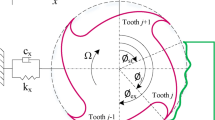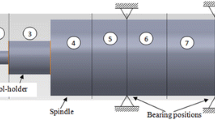Abstract
Background
Periodic cutting forces are inevitably generated during milling processes and the associated forced vibrations leave behind an imprint called surface location error (SLE) on machined parts causing tolerance concerns. Numerical prediction of SLE is extensively demonstrated in literature.
Purpose
However, closed-form models are unarguably preferred over numerical and surrogate models when available due to higher effectiveness and accuracy for design analysis. The few existing closed-form models of forced vibrations and SLE are limited to 1 and 2-DOF systems excited by 1 or 2-dimensional cutting forces (feed and feed-normal directions) for the conventional fixed-helix angle shape even though variable helix angle is a common technical possibility.
Results
This work proposes a closed-form solution that is based on the more realistic 3-dimensional cutting force for the forced vibrations and SLE of arbitrary-DOF milling excited by arbitrary variable helix angle tools. The validity of the proposed model is checked with comparisons to numerical cases of flexible cutting tools (lumped-mass model) and thin-walled workpieces (continuum/finite element model) drawn from literature.
Conclusion
To demonstrate the potential application of the model in SLE suppression without compromising productivity, an optimization problem is formulated and solved for selecting helix angles, and almost complete suppression of SLE is recorded for the illustrative case.








Similar content being viewed by others
Data availability
Data sharing not applicable to this article as no datasets were generated during the current study. The predicted numerical results from the proposed closed-form solution were checked using duly cited published predicted/experimental data.
References
Mann BP, Young KA, Louis S, Schmitz TL, Dilley DN (2005) Simultaneous stability and surface location error predictions in milling. J Manuf Sci Eng 127(3):446–453
Schmitz T, Ziegert J (1999) Examination of surface location error due to phasing of cutter vibrations. Precis Eng 23(1):51–62
Bolsunovskiy S, Vermel V, Gubanov G, Kacharava I, Kudryashov A (2013) Thin-walled part machining process parameters optimization based on finite-element modeling of workpiece vibrations. Proced CIRP 8:276–280
Yuan L, Zeng S, Chen Z (2015) Simultaneous prediction of surface topography and surface location error in milling. Proc Inst Mech Eng C J Mech Eng Sci 229(10):1805–1829
Bachrathy D, Insperger T, Stépán G (2009) Surface properties of the machined workpiece for helical mills. Mach Sci Technol 13(2):227–245
Suh S-H, Cho J-H, Hascoet J-Y (1996) Incorporation of tool deflection in tool path computation: simulation and analysis. J Manuf Syst 15(3):190–199
Chen W, Xue J, Tang D, Chen H, Qu S (2009) Deformation prediction and error compensation in multilayer milling processes for thin-walled parts. Int J Mach Tools Manuf 49(11):859–864
Zuo X, Zhang C, Li H, Wu X, Zhou X (2018) Error analysis and compensation in machining thin-walled workpieces based on the inverse reconstruction model. Int J Adv Manuf Technol 95(5):2369–2377
Honeycutt A, Schmitz TL (2017) Surface location error and surface roughness for period-N milling bifurcations. J Manuf Sci Eng 139(6):061010
Insperger T, Gradišek J, Kalveram M, Stépán G, Winert K, Govekar E (2006) Machine tool chatter and surface location error in milling processes. J Manuf Sci E T ASME 128(4):913–920
Schmitz TL, Couey J, Marsh E, Mauntler N, Hughes D (2007) Runout effects in milling: surface finish, surface location error, and stability. Int J Mach Tools Manuf 47:841–851
Kiss AK, Bachrathy D (2015) Explicit model of cumulative surface location error for milling processes. In: 12th Hungarian Conference on Theoretical and Applied Mechanics. Miskolc, Hungary
Kiss AK, Bachrathy D, Stepan G (2016) Cumulative surface location error for milling processes based on tool-tip frequency response function. Proced CIRP 46:323–326
Wang D, Wang X, Liu Z, Gao P, Ji Y, Löser M, Ihlenfeldt S (2018) Surface location error prediction and stability analysis of micro-milling with variation of tool overhang length. Int J Adv Manuf Technol 99(1–4):919–936
Berglind L, Ozturk E (2019) Modelling of machining processes. Springer International Publishing, Cham, pp 57–93
Sun C, Kengne PLF, Barrios A, Mata S, Ozturk E (2019) Form error prediction in robotic assisted milling. Proced CIRP 82:491–496
Wang D (2021) The comprehensive analysis of milling stability and surface location error with considering the dynamics of workpiece. Technische Universität Dresden, Phd
Surmann T, Enk D (2007) Simulation of milling tool vibration trajectories along changing engagement conditions. Int J Mach Tools Manuf 47(9):1442–1448
Kersting P, Biermann D (2012) Modeling workpiece dynamics using sets of decoupled oscillator models. Mach Sci Technol 16(4):564–579
Biermann D, Kersting P, Surmann T (2010) A general approach to simulating workpiece vibrations during five-axis milling of turbine blades. CIRP Ann 59(1):125–128
Kersting P, Biermann D (2012) Modeling techniques for the prediction of workpiece deflections in NC milling. Proced CIRP 2:83–86
Kersting P, Biermann D (2014) Modeling techniques for simulating workpiece deflections in NC milling. CIRP J Manuf Sci Technol 7(1):48–54
Odendahl S, Kersting P (2013) Higher efficiency modeling of surface location errors by using a multi-scale milling simulation. Procedia CIRP 9:18–22
Siebrecht T, Kersting P, Biermann D, Odendahl S, Bergmann J (2015) Modeling of surface location errors in a multi-scale milling simulation system using a tool model based on triangle meshes. Procedia CIRP 37:188–192
Schmitz TL, Bayly PV, Soons JA, Dutterer B (2001) Prediction of surface location error by time finite element analysis and Euler integration. In: Proceedings of the 17th Annual ASPE Meeting, October 20-25, vol 1. American Society for Precision Engineering, St. Louis, MO, pp 132–137
Mann BP, Bartow MJ, Young KA, Bayly PV, Schmitz TL (2003) Machining accuracy due to tool or workpiece vibrations. Proceedings of the ASME 203 International Mechanical Engineering Congress and Exposition. ASME, Washington, D.C., pp 55–62
Mann BP, Bayly PV, Davies MA, Halley JE (2004) Limit cycles, bifurcations, and accuracy of the milling process. J Sound Vib 277(1–2):31–48
Mann BP, Edes BT, Easley SJ, Young KA, Ma K (2008) Chatter vibration and surface location error prediction for helical end mills. Int J Mach Tools Manuf 48(3–4):350–361
Li Z, Jiang S, Sun Y (2019) Chatter stability and surface location error predictions in milling with mode coupling and process damping. Proc Inst Mech Eng Part B J Eng Manuf 233(3):686–698
Shi DM, Huang T, Zhang XM, Ding H (2022) An explicit coupling model for accurate prediction of force-induced deflection in thin-walled workpiece milling. J Manuf Sci E T ASME 144(8):081005–1
Ding Y, Zhu L, Zhang X, Ding H (2011) On a numerical method for simultaneous prediction of stability and surface location error in low radial immersion milling. J Dyn Syst Meas Control Trans ASME 133(2):024503
Eksioglu C, Kilic ZM, Altintas Y (2012) Discrete-time prediction of chatter stability, cutting forces, and surface location errors in flexible milling systems. J Manuf Sci Eng 134(6):1–13
Dai Y, Li H, Peng D, Fan Z, Yang G (2022) A novel scheme with high accuracy and high efficiency for surface location error prediction. Int J Adv Manuf Technol 118(3–4):1317–1333
Dai Y, Li H, Yao J, Liu S (2019) A novel approach with time-invariant transition matrix for surface location error prediction in low radial immersion milling. Int J Adv Manuf Technol 101(5–8):1267–1274
Schmitz TL, Mann BP (2006) Closed-form solutions for surface location error in milling. Int J Mach Tools Manuf 46(12–13):1369–1377
Kiran K, Rubeo M, Kayacan MC, Schmitz T (2017) Two degree of freedom frequency domain surface location error prediction. Precis Eng 48:234–242
Zhang J, Lin B, Fei J, Huang T, Xiao J, Zhang X, Ji C (2018) Modeling and experimental validation for surface error caused by axial cutting force in end-milling process. Int J Adv Manuf Technol 99(1–4):327–335
Korovin G, Petrushin S, Gubaidulina R (2018) Machining of titanium alloys with wave milling cutters. Mater Sci Forum 927:79–85
Tehranizadeh F, Budak E (2022) Special milling tools to suppress self-excited chatter vibrations in milling. IFAC-PapersOnLine 55(36):115–120
Kline WA, Devor RE, Lindberg JR (1982) The prediction of cutting forces in end milling with application to cornering cut. Int J Mach Tool Des Res 22(1):7–22
Kline WA, Devor RE, Shareef IA (1982) The prediction of surface accuracy in end milling. J Manuf Sci E T ASME 104(3):272–278
Budak E, Altintas Y (1995) Modeling and avoidance of static form errors in peripheral milling of plates. Int J Mach Tools Manuf 35(3):459–476
Li W, Wang L, Yu G (2021) Force-induced deformation prediction and flexible error compensation strategy in flank milling of thin-walled parts. J Mater Process Technol 297:117258
Gui H, Zhang L, Yan Y (2022) Adaptive tool path generation for flank milling of thin-walled parts based on force-induced deformation constraints. Int J Adv Manuf Technol 119(5):3631–3646
Wang L, Li W, Yu G (2023) Optimal deformation error compensation process in flank milling of thin-walled workpieces. Int J Adv Manuf Technol 126(9):4353–4367
Ozoegwu CG, Eberhard P (2022) Closed-form models for the cutting forces of general-helix cylindrical milling tools. Proc Inst Mech Engi Part B J Eng Manuf. https://doi.org/10.1177/09544054221141130
Ozoegwu CG, Eberhard P (2022) Geometric definition, rapid prototyping, and cutting force analysis of cylindrical milling tools with arbitrary helix angle variations. Proc Inst Mech Eng Part B J Eng Manuf 236(9):1232–1246
Ozoegwu CG, Eberhard P (2023) Upgraded closed-form cutting force models for general-helix cylindrical milling tools with application to cutting power and energy demand modeling. Proc Inst Mech Eng Part B J Eng Manuf. https://doi.org/10.1177/09544054231181158
Baumann M, Eberhard P (2017) Interpolation-based parametric model order reduction for material removal in elastic multibody systems. Multibody SysDyn 39(1):21–36
Hamann D, Eberhard P (2018) Stability analysis of milling processes with varying workpiece dynamics. Multibody SysDyn 42(4):383–396
Ozoegwu CG (2020) Polynomial tensor-based stability identification of milling process: application to reduced thin-walled workpiece. In: Fehr J, Haasdonk B (eds) IUTAM symposium on model order reduction of coupled systems, stuttgart, Germany, May 22–25, 2018. Springer International Publishing, Cham, pp 209–220
Ozoegwu CG, Eberhard P (2021) Automated upgraded generalized full-discretization method: application to the stability study of a thin walled milling process. In: Dixit U, Dwivedy S (eds) Mechanical sciences: the way forward, ch. 4. Springer Nature, Singapore, pp 83–104
Adem KA, Fales R, El-Gizawy AS (2015) Identification of cutting force coefficients for the linear and nonlinear force models in end milling process using average forces and optimization technique methods. Int J Adv Manuf Technol 79(9–12):1671–1687
Mohd Hadzley AB, Nurul Fatin MR, Izamshah R, Siti Sarah A, Kasim MS, Ali MA, Sulaiman MA (2015) Effects of helix angle on cutting performance for machining thin-wall aerospace monolithic component. Appl Mech Mater 699:3–8
Budak E, Altintas Y (1994) Peripheral milling conditions for improved dimensional accuracy. Int J Mach Tools Manuf 34(7):907–918
Wan M, Zhang WH (2006) Calculations of chip thickness and cutting forces in flexible end milling. Int J Adv Manuf Technol 29(7–8):637–647
Bera TC, Desai KA, Rao PV (2011) Error compensation in flexible end milling of tubular geometries. J Mater Process Technol 211(1):24–34
Wan M, Feng J, Zhang WH, Yang Y, Ma YC (2017) Working mechanism of helix angle on peak cutting forces together with its design theory for peripheral milling tools. J Mater Process Technol 249:570–580
Moufki A, Dudzinski D, Coz GL (2015) Prediction of cutting forces from an analytical model of oblique cutting, application to peripheral milling of Ti-6Al-4V alloy. Int J Adv Manuf Technol 81:615–626
Funding
The described research was done while Chigbogu Ozoegwu visited the ITM at the University of Stuttgart from 2022 to 2023. This stay was funded by the Alexander von Humboldt Foundation. This support is highly appreciated.
Author information
Authors and Affiliations
Corresponding author
Ethics declarations
Conflict of Interest
The authors have no relevant financial or non-financial interests to disclose.
Additional information
Publisher's Note
Springer Nature remains neutral with regard to jurisdictional claims in published maps and institutional affiliations.
Appendix
Appendix
A: Coefficients in Equation 11
Rights and permissions
Springer Nature or its licensor (e.g. a society or other partner) holds exclusive rights to this article under a publishing agreement with the author(s) or other rightsholder(s); author self-archiving of the accepted manuscript version of this article is solely governed by the terms of such publishing agreement and applicable law.
About this article
Cite this article
Ozoegwu, C., Eberhard, P. Closed-Form Time-Domain Solutions of Arbitrary-DOF Forced Vibrations and of Surface Location Error for General-Helix Cylindrical Milling Tools. J. Vib. Eng. Technol. 12, 3563–3574 (2024). https://doi.org/10.1007/s42417-023-01064-7
Received:
Revised:
Accepted:
Published:
Issue Date:
DOI: https://doi.org/10.1007/s42417-023-01064-7




